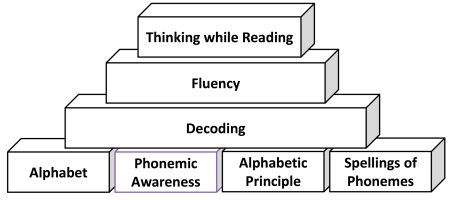
RoxieReading is research-based.
RoxieReading is based on the following three critical areas of research.
1. How the brain processes words
RoxieReading is based on nearly 30 years of scientific research by neuroscientists and other researchers worldwide. Scientists discovered that proficient readers process words mainly in the language centers found in the left side of the brain (Shaywitz, 1996, Shaywitz, et. al., 2004). In contrast, poor readers of all ages activate networks in the right side of brain with poor activation in the left side language centers (Moats, 2009, Papanicolaou, et. al., 2003). However, when these struggling readers are taught a research-based approach to reading, the activation switches to the networks on the left side of the brain (Simos, et. al., 2002; Shaywitz, et. al., 2004). What does this tell us? That efficient reading takes place in the languages centers of the left side of the brain and reading instruction must support the development of those structures. With this knowledge of the brain along with the results of scientific causal and correlational studies, we are able to construct a framework for teaching reading that is effective for almost all learners.
RoxieReading uses this framework for teaching reading as the basis for assessment and instruction. It focuses on these skills:
- Phonemic awareness
- Understanding of the alphabetic principle
- Knowledge of the graphemes (spellings of phonemes)
- Ability to construct words using this knowledge
- Ability to decode both single and multisyllable words
- Fluency
- Reading Comprehension

References
Moats (2009). The challenge of learning to read, 2nd ed. Longmont, CO: Sopris West Educational Services
Papanicolaou AC, Simos PG, Fletcher J.M, et al (2003). Early development and plasticity of neurophysiological processes involved in reading, in Foorman, B.F. (ed): Preventing and Remediating Reading Difficulties: Bringing Science to Scale. Baltimore, MD, York Press, 2003, p.3-21.
Shaywitz, S. (November 1996). 10 years of brain imaging research shows the brain reads sound by sound. Scientific American, pp. 98-104. Retrieved from http://kidsadhd.com/learning/brain.shtml
Shaywitz, B. A., Shaywitz, S. E., Pugh, K. R., Mencl, W. E., Fulbright, R.K., Skudlarski, P., . . .& Gore, J. C. (2002). Disruption of posterior brain systems for reading in children with developmental dyslexia. Society of Biological Psychiatry.
Shaywitz, S (2003). Overcoming Dyslexia. New York, Ny: Alfred A. Knopf, a division of Random House, Inc.
Shaywitz, B. A.. Shaywitz, S.E., Blachman, B. A., Pugh, K.R. Fulbright, ,R. K. , Skudlarski, P. . . .& Goret, J. C. (May 2004). Development of left occipitotemporal systems for skilled reading in children after a phonologically based intervention. Biological psychiatry 255, p. 926-933.Found online at http://www.haskins.yale.edu/papers/intervention_biol_psych_200.pdf
Simos, P.G., Fletcher, J.M., Bergman, E., Breier, J.I., Foorman, B.R., Castillo, E.M.,. . .& Papanicolaou, A.C. (April 2002). Dyslexia-specific brain activation profile becomes normal following successful remedial training. Neurology, 58.
2. The orthographic structure of English
An understanding of the orthographic structure (how words are spelled) of English is critical to teaching and learning English. The mismatch between the number of sounds and the number of letters in our alphabet is one of the sources of the problem. In a detailed analysis of the orthographic structure of English, Venezky (1970) presents a case for understanding the apparent anomalies of the language.
First of all, English is a language that reflects its history, revealing layers of influence by different cultures. The base is Anglo-Saxon with a handful of Germanic words for everyday use. Although the Anglo-Saxon gives the complex and irregular spelling such as ough, it is also the foundation of the simple consonant-vowel-consonant structure of several thousand words (Balmuth, 1982; Calfee & Henry, 1996). On this Anglo-Saxon base is a large layer of Romance words, residue from two decades of Norman French rule. On top of that, scholars and scientists imported Latin and Greek. Graphemes have been borrowed from each of these language groups.
Secondly, English must be taught and understood at the level of phonemes and the graphemes that represent them rather than at the level of syllables.. The ability to process letters and letter patterns critically affects the efficiency and fluency in early reading (Adams, 1990; Foorman, 1996; Share & Stanovich, 1995).
Last of all, the structure of English as described by Venezky (1970) gives insight into the regularity and organization of the language. Venezky (1976) states, “There is a difference between letter-sound regularity and orthographic regularity . . .[An example is] the i in business. From a letter-sound standpoint and the perspective of phonics conventions, business is highly irregular. Those who point out the irregularity of English are looking on the syllabic level. However, the sequence of consonants and vowels are very predictable according to orthographic rules making it orthographically regular.” (p. 34)
The “Real Rules” of English found in RoxieReading is a distillation of this research on the structure of English at the grapheme, rather than the syllabic level. These are the principles that govern the way graphemes operate in words. This makes our curriculum distinctive because we use a strict approach to teaching only the graphemes with their governing principles. The language becomes predictable and regular, making it easier for the lowest achiever to learn.
References
Calfee, R., & Henry, M. (1996). Strategy and skill in early reading acquisition. In J. Shimron (Ed), Literacy and education: essays in memory of Dina Feitelson (pp. 47-68). Cresskill, NJ: Hampton Press.
Balmuth, M. (1982). The roots of phonics. New York: McGraw-Hill.
Venezky, R. L. (1970). The structure of English orthography. The Hague, Paris: Mouton.
Venezky, R. L. (1976). Best kept secret about reading. Paper presented at a conference on Theory and Practice of Beginning Reading Instruction, University of Pittsburgh, Learning Research and Development Center.
3. How we learn
Researchers have identified three principles of teaching and learning that produce extraordinary results in student learning. RoxieReading incorporates these principles into the curriculum.
Principle #1: Students construct their own understanding of concepts.
“In order for a child to understand something, he must construct it himself, he must re-invent it” (Piaget 1972, cited in Chomsky 1979, p. 49). The key word is construct. Students are not listening to the teacher give extended detailed explanations, but instead, they are producing a product using the concepts and principles that have been introduced. It is in the process of producing that the concepts are understood at deeper and deeper levels. This personal endeavor results in internalized concepts, rules, and general principles. They are not just memorized by rote.
A vital part of the construction of knowledge is dialogue. Vygotsky (1978) proposed that verbalizing the justification for choices helps solidify concepts and expedites transfer to new situations. This type of learning “comes about not from isolated study but from social exchange” (Moran & Calfee 1993, p. 208).
Principle #2: Questions are used as cues to prevent errors before they are made.
In this approach to teaching and learning, emphasis is on dialogue and understanding rather than on recitations, worksheets, and copying (Moran & Calfee 1993). Questions guide students in processing the information. The teacher anticipates any errors students might make and devises ways to mediate the learning before a mistake is made. Using objects, phrases, questions, or other concrete means, the teacher is able to guide the student’s thinking (Bodrova & Leong 1996). This instructional method is called “errorless learning.”
Principle #3: Learning is not a point on a scale but a continuum of behaviors.
The zone of proximal development (ZPD) is a concept developed by Vygotsky (1978) that describes the difference between what a learner can do with help and what he or she can do without help. At the lower level of the zone is what students can do independently without any help from the teacher. At the higher level of the zone is the maximum students can perform with some assistance. This help may include hints, clues, rephrasing, or asking students to restate what they understand. In traditional education, these higher levels in the zone of proximal development receive very little attention. Teaching and assessing is usually only focused on what the student can do independently. With Vygotsky’s model, we have a way to successfully teach more difficult concepts. Learning is not a point in time, but a gradual understanding of concepts with various levels of assistance. Mastery comes with time and practice.
References
Bodrova, E., & Leong, D. J. (1996). Tools of the mind: A Vygotskian approach to early childhood education. Englewood Cliffs, NJ: Prentice-Hall.
Chomsky, C. (1979). Approaching reading through invented spelling. In Resnick and Weaver, (Eds.), Theory and practice of early reading, Vol.2. Hillsdale, NJ: Erlbaum.
Moran, C., & Calfee, R. (1993). Comprehending orthography: social construction of letter-sound in monolingual and bilingual programs. Reading and Writing: An Interdisciplinary Journal, 5, 205-225.
Vygotsky, L. S. (1978). Mind in society: The development of higher psychological processes. Cambridge, MA: Harvard University Press.